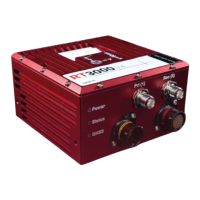Oxford Technical Solutions Ltd Page 69 of 110
Analogue tab
The Analogue option is used for configuring the RT-ANA companion product. There are 16 channels in the RT-
ANA, numbered from 0 to 15. The Measurement, Range, and Min and Max values for all 16 channels can be
configured. Click on a specific cell to change the settings.
Note: The CAN bus must be configured correctly for the analogue outputs to work correctly.
PPS / Triggers tab
The output trigger on the digital I/O generates a pulse based on distance. Select the distance interval to
generate the pulses on from the dropdown list, or type in a value. The output has 0.8 V or less for a low and 2.4
V or more for a high. The pulse width is 1 ms.
PTP tab
To configure the RT as a PTP master, select the “enable PTP” checkbox. Different time epochs can then be
configured by selecting the “Time Epoch” checkbox and then selecting from PTP, GPS, UNIX or UTC from the
dropdown list.
NAVconfig Environment section
This section contains settings related to the environment you will be collecting data in, including the device
initialisation conditions. This section is not broken down into tabs but contains several selectable options and
pre-defined values on one screen.
Initialisation
Static initialisation is disabled by default.
If static initialisation has not been enabled, the RT will need to be initialised by driving forwards in a straight
line to initialise the heading to the track angle. The initialisation speed is the speed at which the vehicle must
travel to activate the initialisation.
The default initialisation speed is 5 m/s. However, some slow vehicles cannot achieve this speed. For these
vehicles adjust the initialisation speed to a different value.
If a speed less than 5 m/s is selected, then care should be taken to make sure that the RT is travelling straight
when it initialises.
Vehicle starts
Select a predefined value from the dropdown list.
If you know the vehicle will be level when starting (to within about 5°) select ‘Level’. This saves about 40 s during
the initialisation process since the RT does not have to take the time to compute an initial roll and an initial
pitch. In high vibration environments Not Level may not work and so the RT can only start if the vehicle is level
and the Level option has been specified.

